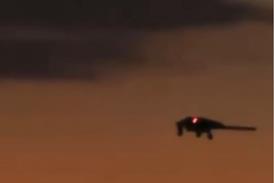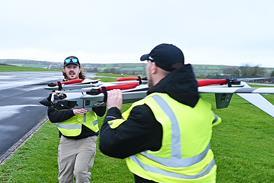The fact that no aircraft system alarms triggered before a 2013 LAM Mozambique Embraer 190 crash has led Namibian investigators to conclude that the captain deliberately disengaged multiple systems before the aircraft crashed. The aircraft had been cruising at 38,000ft when cockpit voice recordings picked up the sound of the altitude pre-select being dialled to 4,288ft, then to 1,888ft and again to 592ft. Shortly afterwards the autothrottle was disengaged and one of the air conditioning packs deactivated. Neither event generated a caution alarm, and the Namibian transport ministry, in an interim statement, says this indicates the actions were intentional. Similarly, the aircraft’s mode was subsequently switched from ‘altitude hold’ to ‘flight-level change’ without any evidence of a failure of the flight management system. “Therefore it is possible to infer that these transitions were manually commanded,” the inquiry states. The captain had been alone as the first officer had left for the lavatory. Flight data recorder information shows that the jet departed from its assigned altitude and began a rapid straight-line descent that lasted for 6min 42s before Namibian radar lost contact. The rate of descent reached a maximum 10,560ft/min and a nose-down pitch of 10˚, triggering several overspeed warnings. The aircraft crashed in Bwabwata National Park. None of the six crew members or 27 passengers survived. Investigators have not yet drawn any official conclusions from the recorded information, but there is little in the interim statement to counter early suspicions that the flight was sabotaged by the captain. No distress call was made, although the crew had been in radio contact with Gaborone controllers before the sudden descent at the EXEDU waypoint. The Namibian inquiry states that “no mechanical faults were detected”, and the first officer left the cockpit minutes before the 29 November 2013 crash. “Repeated banging” on the cockpit door is suspected to have been the copilot's attempt to gain access to the flightdeck.
Italian investigators have concluded that a Wind Jet Airbus A319 that landed well short of Palermo’s runway did so after deciding to continue a non-precision approach at night in poor weather, despite failing to sight the runway at the minimum descent altitude (MDA). The accident occurred on 24 September 2010. Italian investigation authority ANSV has determined that the pilots demonstrated a “poor attitude” towards crew resource management and failed to maintain a sterile cockpit during the descent, or to carry out proper approach briefings. The aircraft landed 367m (1,200ft) short of the runway 07 threshold and skidded for 850m, suffering such extensive damage that the twinjet was written off. The ANSV says there was “deliberate disregard” for procedures at the point of reaching the MDA, when the crew is supposed to confirm the runway as being in sight – and execute a go-around if it is not. However, as the aircraft crossed the minimum altitude of 710ft, the captain urged the first officer, who was flying, to continue the approach despite being unable to confirm a runway sighting. The first officer subsequently identified the runway at 480ft, and the captain took control of the aircraft. At 240ft the first officer exclaimed that he saw “four red” – a reference to the precision approach path indicator lamps, which showed the A319 was far below the correct glidepath. The inquiry says the adverse weather and darkness, combined with the descent over water, created a “black hole” illusion which led the pilot to believe the aircraft was high on the approach. The A319 crossed over the airport’s terminal VOR beacon at a height of 92ft – less than half the 200ft expected for a normal glideslope at that point. Thirty-four passengers and a crew member suffered minor injuries in the event.
· Danish investigators reporting on a 29 January 2014 Air Greenland de Havilland Canada Dash 8-200 accident determined that the crew carried out an unstable steep approach to Ilulissat in above-limit crosswinds. The resulting hard landing caused a main-gear collapse and the aircraft was destroyed as it skidded off runway 07 and down a snow-covered slope, although only minor injuries were sustained among the 15 occupants. Danish investigation authority HCL found that the crew had agreed to a visual steep approach of 5.1˚ and a reference airspeed of 99kt (183km/h). They also accepted a crosswind limitation 6kt above the operator’s limit of 25kt, so the landing should have been abandoned. The wind conditions and chosen low flap setting of 15˚ “made it difficult” to maintain stabilised approach criteria. As it passed below 1,000ft the Dash 8’s airspeed was still at 144kt – exceeding the operator’s stable-approach maximum of 119kt for the aircraft’s configuration. The crew retarded the throttle levers to the flight-idle setting at 200ft, causing the aircraft to descend more rapidly – in excess of 1,000ft/min – and sink beneath the 5.1˚ glideslope. This descent rate increased to 1,100ft/min at 50ft, with the airspeed still at 128kt. HCL says the crew developed “target fixation” and a “mental blocking” of any decision to execute a go-around. While still airborne, below a height of 20ft, the crew retarded the throttle below the flight-idle setting into the ‘beta range’ designed for use only on the ground. The HCL observes: “At that point, no safety barriers were left.” With a 6.6˚ left bank, the Dash 8 touched down hard on its left main landing-gear with an impact of 2.4g, and it collapsed.
· The Japan Transport Safety Board (JTSB) released findings from an investigation into the 16 January 2013 main battery incident aboard an All Nippon Airways Boeing 787 which resulted in an emergency landing and contributed to a global grounding of the type. While the 100-page investigation report does not identify a specific cause for the lithium-ion battery failure aboard ANA flight 692, it provides probable causes and has recommendations for both the US Federal Aviation Authority and Boeing. “Internal heat generation in cell six very likely developed into venting, making it the initiating cell, resulting in cell-to-cell propagation and subsequent failure of the main battery,” the report says. “It is very likely that cell six internal heat generation and increased internal pressure caused it to swell, melt the surrounding insulation material and contact the brace bar, creating a grounding path that allowed high currents to flow through the battery box. The currents generated arcing internal to the battery that contributed to cell-to-cell propagation consequently destroying the battery.” It adds that the heat generation in cell six was “probably” due to a short circuit, but stresses that “the conclusive mechanism thereof was not identified”. During the Yamaguchi Ube-Tokyo flight the flightcrew received several battery warnings and smelled fumes in the cockpit. They made an emergency landing at Takamatsu, where all 129 passengers and eight crew were evacuated via the aircraft’s slides. The ANA incident followed another lithium-ion battery failure on 11 January 2013, aboard a Japan Air Lines 787 parked at Boston Logan International airport. Echoing comments from both the NTSB and Boeing itself, the JTSB states that the airframer’s original testing regimen for the battery was insufficient, mainly because it did not adequately simulate a realistic operational scenario. The board recommends that the FAA instruct manufacturers to test equipment under conditions simulating actual aircraft configurations, and review the technical standards for testing lithium-ion batteries. Boeing has since redesigned the battery and its stowage area.
· The final report into the crash of a Lion Air Boeing 737-800 into the sea on short final to land at Denpasar's Ngurah Rai International airport on 13 April 2013 has identified several pilot skill deficits and failures in the carrier's emergency response procedures. The National Transportation Safety Committee (NTSC) report highlights the failure of the captain and first officer to communicate effectively during the approach. The report also refers to CCTV footage that shows the bad weather and poor visibility immediately prior to the crash that prevented the flightcrew from seeing the runway. The first officer, who was flying, mentioned that the runway was not in sight as the aircraft descended through 900ft on final approach after an uneventful flight from Bandung. Although the aircraft's automated systems issued a "minimum" warning at 550ft, the crew disengaged the autopilot and autothrottle and continued the descent manually. At 300ft the cockpit voice recorder identifies a sound consistent with rain hitting the windshield. When the 737 had descended to just 150ft, the captain took control and the first officer again said he could not see the runway. After the enhanced ground proximity warning system called a 20ft height alert the pilot commanded a go-around but, just 1s later, the aircraft impacted the water. Although there were no fatalities among the 101 passengers and seven crew, four passengers suffered serious injuries. The aircraft (PK-LKS) was a complete loss. The report also shows that the crew handled evacuating the passengers from the aircraft poorly. The first officer initially attempted to evacuate passengers from the jet through the right cockpit window. When this proved unviable, he conducted the evacuation through the right-hand service door. Meanwhile, a flight attendant on the left side of the twinjet was unable to detach a life raft from the aircraft, as her only training for this exercise consisted of watching a video. The report contains 13 recommendations for five parties including Lion Air, airport operator PT Angkasa Pura I and the Directorate General of Civil Aviation. The key recommendations, however, focus on ensuring the pilots have effective crew resource management skills, hand flying skills and emergency procedures.
· French investigators have determined that fatigue cracking in the undercarriage of an ACT Airlines Airbus A300B4 freighter caused the left main landing-gear to collapse after touchdown in Afghanistan. The aircraft (TC-ACB) had been arriving at Bagram air base after a cargo service from Bahrain on 1 March 2010. Its crew had already been alerted to a possible problem during the visual approach to runway 21 because cockpit indications showed the left main gear was not locked, and an absence of pressure in the green hydraulic system. The A300 carried out two passes over the tower for air traffic controllers to observe the state of the undercarriage. It appeared normal. About 18s after touchdown, during braking, the left gear collapsed, says French investigation authority BEA. The A300 departed the runway and came to rest 2,000m (6,560ft) beyond the threshold. All five crew evacuated from the aircraft without injury. BEA says the articulating arm at the top of the main gear leg fractured due to fatigue cracking – adding that this fracture “probably” occurred as the gear retracted after take-off. The left gear subsequently deployed under gravity when the undercarriage was extended for landing, leading to a hydraulic leak. BEA’s inquiry states that some maintenance tasks on the gear, during its last overhaul at Turkish Technic, were “not completed in the prescribed manner”. Pitting and corrosion in the landing-gear assembly went undetected. Turkish Technic and landing-gear manufacturer Messier-Bugatti-Dowty subsequently carried out a review of procedures, with Messier and Airbus emphasising the need to apply corrosion protection promptly to parts awaiting plating treatment.
Source: Flight International























